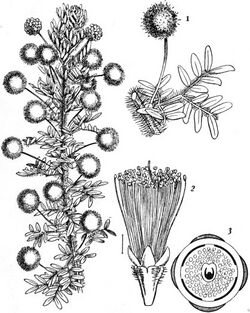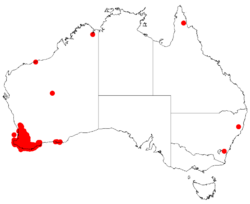Biology:Acacia browniana
| Brown's wattle | |
|---|---|

| |
| Scientific classification | |
| Kingdom: | Plantae |
| Clade: | Tracheophytes |
| Clade: | Angiosperms |
| Clade: | Eudicots |
| Clade: | Rosids |
| Order: | Fabales |
| Family: | Fabaceae |
| Subfamily: | Caesalpinioideae |
| Clade: | Mimosoid clade |
| Genus: | Acacia |
| Species: | A. browniana
|
| Binomial name | |
| Acacia browniana W.L.Wendl.
| |

| |
| Occurrence data from AVH | |
Acacia browniana, commonly known as Brown's wattle, is a shrub of the genus Acacia and the subgenus Pulchellae. It is native to an area in the South West and Peel regions of Western Australia.[1]
Description
The shrub typically grows to a height of 0.2 to 2 metres (0.7 to 6.6 ft).[1] The pinnae form in pairs along the branchlet. The proximal pinnae are 1 to 4 millimetres (0.04 to 0.16 in) in length while the distal are 2 to 30 mm (0.08 to 1.18 in) long.[2] It blooms from May to November and produces cream-yellow flowers.[1] Each inflorescence is simple forming one or two per axil. The heads have a globular shape that is sometimes obloid with a diameter of 4 to 6 mm (0.16 to 0.24 in) composed of 12 to 21 flowers. Following flowering it will form green, glabrous narrowly-oblong seed pods with a length of 1 to 4.5 cm (0.4 to 1.8 in) and 5 to 9 mm (0.20 to 0.35 in) wide. the brown seeds have an oblong to elliptic shape and are 2 to 4 mm (0.08 to 0.16 in) long.[2]
Classification
The species was first formally described by the botanist Heinrich Wendland in 1819 as part of the work Flora: oder Allgemeine Botanischer Zeitund. Synonyms for this species include Acacia strigosa and Racosperma brownianum.[3]
There are five varieties:
- Acacia browniana var. browniana
- Acacia browniana var. endlicheri
- Acacia browniana var. glaucescens
- Acacia browniana var. intermedia
- Acacia browniana var. obscura
Distribution
The plant is found in wet areas, near such as around streams and rivers, also on flats and ridges, hills and among granite outcrops[1] in south western Western Australia from around Bindoon and Mogumber in the north around the coast to Augusta in the south and Manypeaks.[2] It grows well in sandy, loamy, gravelly soils often containing laterite.[1]
See also
References
- ↑ Jump up to: 1.0 1.1 1.2 1.3 1.4 "Acacia browniana". FloraBase. Western Australian Government Department of Parks and Wildlife. https://florabase.dpaw.wa.gov.au/browse/profile/3247.
- ↑ Jump up to: 2.0 2.1 2.2 "Acacia browniana". WorldWideWattle. Department of Parks and Wildlife. http://worldwidewattle.com/speciesgallery/browniana.php. Retrieved 27 March 2018.
- ↑ "Acacia browniana H.L.Wendl.". Atlas of Living Australia. Global Biodiversity Information Facility. https://bie.ala.org.au/species/http://id.biodiversity.org.au/node/apni/2889160#names. Retrieved 27 March 2018.
Wikidata ☰ Q9562906 entry
 |

